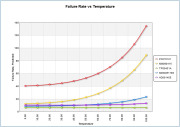Reliability Prediction Models
Note: This is the second part of a three-part article. Part 1 identified the major factors in reliability prediction models that contribute to predicting component failure. This article, Part 2, describes the most widely accepted reliability prediction standards applied in current projects. Part 3 will provide guidelines for making a sound judgment when deciding which standard to apply to a particular analysis.


